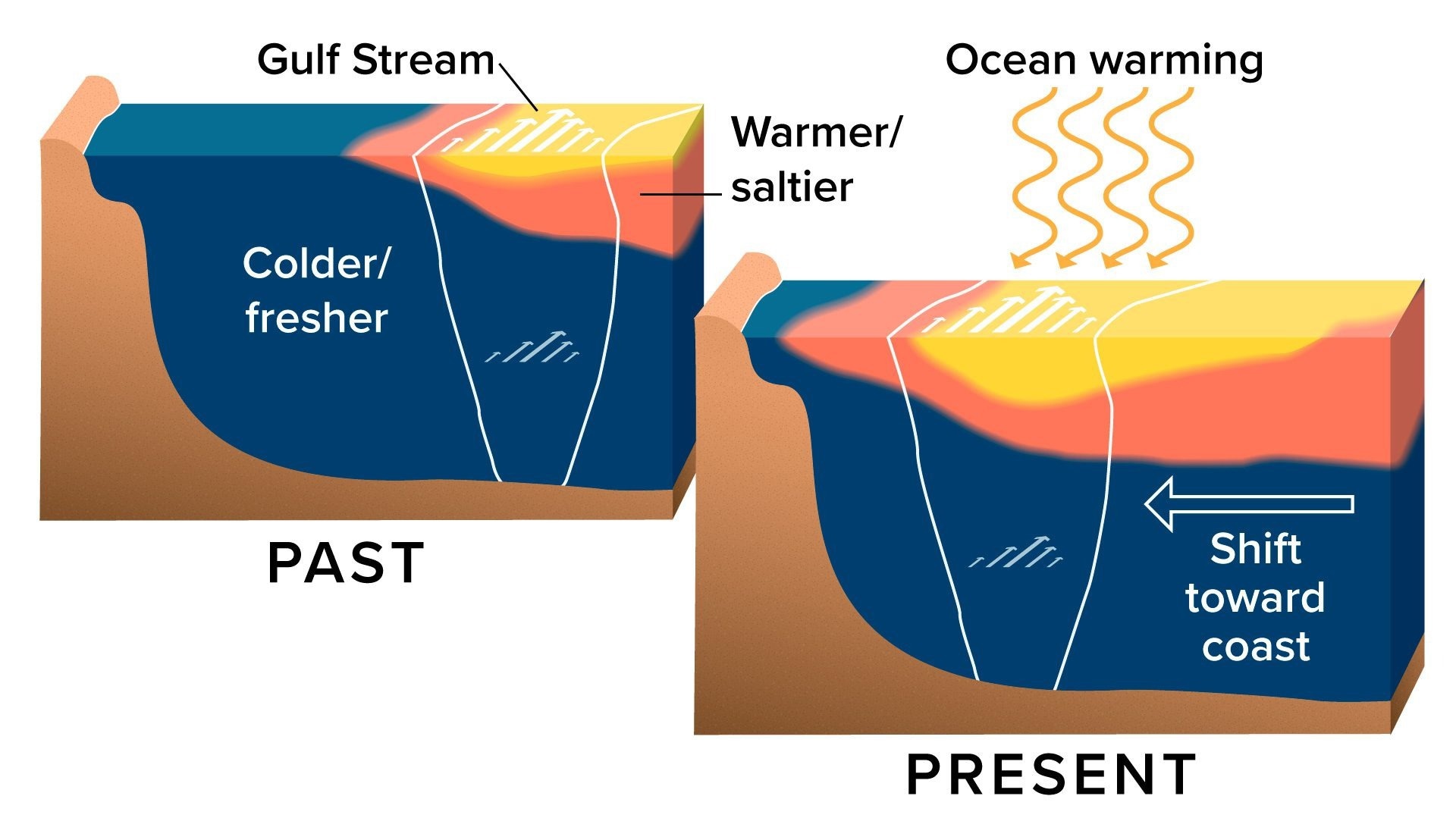The Gulf Stream plays a pivotal role in the global climate system by transporting warm waters from the Caribbean along the East Coast of the United States. As it continues its journey along the coast and across the Atlantic Ocean, this formidable ocean current exerts a significant influence on weather patterns and storms while also transporting tropical heat to higher latitudes as part of the Atlantic Meridional Overturning Circulation.
 Warming in and near the Gulf Stream at present, compared to the early 21st century, is driven by heat from the atmosphere and a gradual shift of the Gulf Stream toward the coast. Image Credit: Natalie Renier ©Woods Hole Oceanographic Institution.
Warming in and near the Gulf Stream at present, compared to the early 21st century, is driven by heat from the atmosphere and a gradual shift of the Gulf Stream toward the coast. Image Credit: Natalie Renier ©Woods Hole Oceanographic Institution.
In a recently published study in Nature Climate Change, it has been revealed that during the past two decades, the Gulf Stream has exhibited a faster warming rate than the overall global ocean, and it has shifted closer to the coastline.
The research, spearheaded by Robert Todd, a Physical Oceanographer at the Woods Hole Oceanographic Institution (WHOI), draws upon a dataset of more than 25,000 temperature and salinity profiles collected between 2001 and 2023.
The warming we see near the Gulf Stream is due to two combined effects. One is that the ocean is absorbing excess heat from the atmosphere as the climate warms. The second is that the Gulf Stream itself is gradually shifting towards the coast.
Robert Todd, Physical Oceanographer, Woods Hole Oceanographic Institution
Robert Todd, along with study co-author Alice Ren, a Physical Oceanographer at WHOI, conducted an analysis highlighting the most significant alterations in the near-surface layer of the Gulf Stream. According to their findings, this layer has experienced an average warming of approximately 1 °C (2 °F) over the past two decades, causing it to become less dense than the underlying waters.
The research team observed that the Gulf Stream is progressively shifting towards the coastline, advancing by an average of 5 km (3.1 miles) per decade. This gradual movement brings the Gulf Stream closer to the continental shelf of the Northeastern United States.
One of the triumphs of this paper is that it provides observational confirmation of something that numerical simulations have predicted in a warming climate.
Robert Todd, Physical Oceanographer, Woods Hole Oceanographic Institution
To discern these patterns, the researchers relied on observational data from two key sources: the Spray autonomous underwater gliders and the Argo Program. The Spray gliders are autonomous underwater vehicles that traverse the ocean, while the Argo Program comprises approximately 4,000 autonomous profiling floats designed to drift with ocean currents.
These floats move up and down between the ocean's surface and depths of approximately 2000 m (6560 feet), collecting data throughout their ascent. The Argo Program, an international initiative in operation since 1999, has played a pivotal role in gathering oceanographic data. WHOI is among the original Argo institutions and manages around 10% of the Argo float array.
Todd and Ren have been deploying Spray gliders off the Florida coast every two months to enhance their understanding of the Gulf Stream. Similar to Argo floats, these gliders traverse vertically and horizontally, with the added capability to maneuver through the water and traverse the Gulf Stream as it propels northward.
These gliders and floats complement the satellite-based ocean surface water temperature assessments by supplying measurements beneath the Gulf Stream's surface.
It can be difficult to make predictions about a current like the Gulf Stream using numerical modeling. Our paper is important in that it provides observational details about our changing weather and changing climate.
Alice Ren, Physical Oceanographer, Woods Hole Oceanographic Institution
Similar to the atmospheric jet stream, the Gulf Stream exhibits swaying and oscillatory behavior within the ocean. Todd noted that as its average position approaches the coastline, these substantial oscillations could have a more pronounced and abrupt impact on coastal fisheries. For instance, water temperatures could experience a rapid transition from 12 °C to 20 °C within a brief period.
Ocean temperatures are on a consistent upward trend due to human activities, including the combustion of fossil fuels that release heat-trapping greenhouse gases into the atmosphere. Nonetheless, the fundamental forces governing the Gulf Stream, such as atmospheric wind patterns and the Earth's rotation, will persist even in a changing climate. Consequently, there is no reason for concern that the Gulf Stream will cease to function.
“That’s not to say that it won’t shift or change its strength, but those basic ingredients are all it takes to have a warm, fast Gulf Stream flowing along the U.S. East Coast,” adds Todd.
The research received funding from the National Science Foundation, Office of Naval Research, NOAA Global Ocean Monitoring and Observing Program, WHOI, and Eastman. Spray glider operations in the Gulf Stream have relied on P. Deane (WHOI) and the Instrument Development Group at the Scripps Institution of Oceanography. Alice S. Ren was supported by the Postdoctoral Scholar Program at WHOI, with funding provided by the Doherty Foundation.
Spray glider launch to monitor Gulf Stream
Video Credit: Woods Hole Oceanographic Institution
Journal Reference:
Todd, R. E. & Ren, A. S. (2023) Warming and lateral shift of the Gulf Stream from in situ observations since 2001. Nature Climate Change. doi.org/10.1038/s41558-023-01835-w.